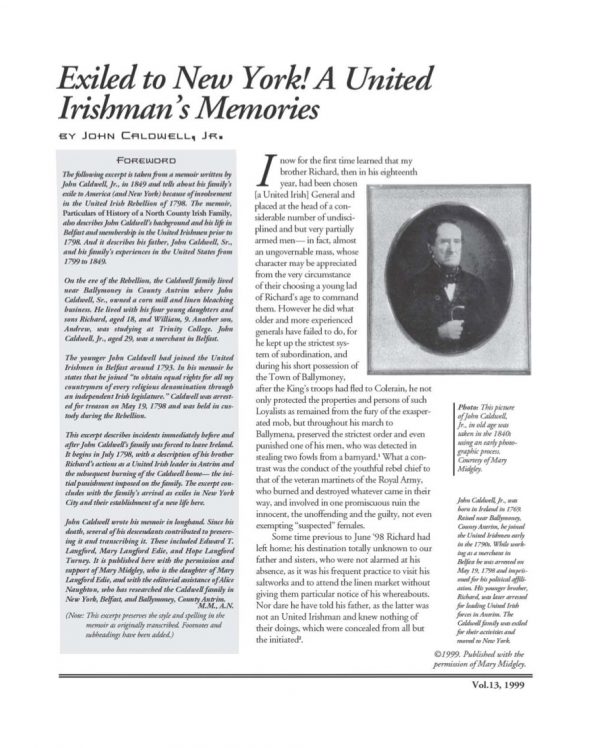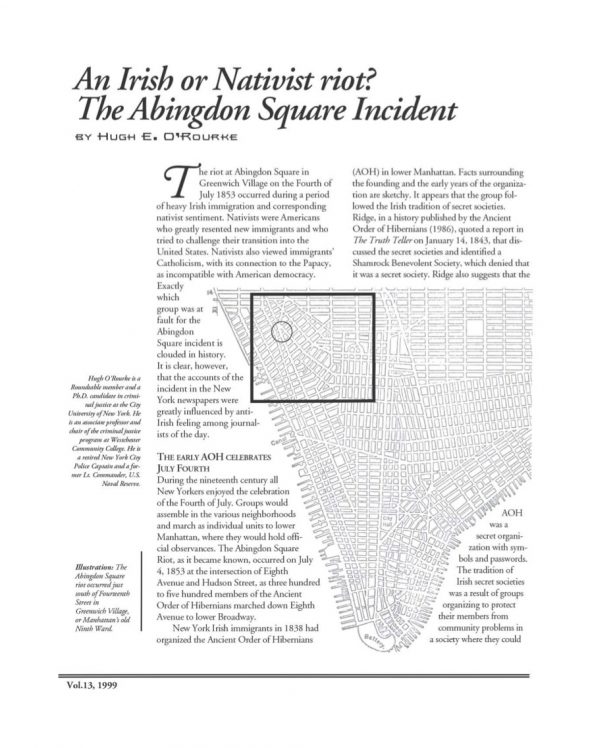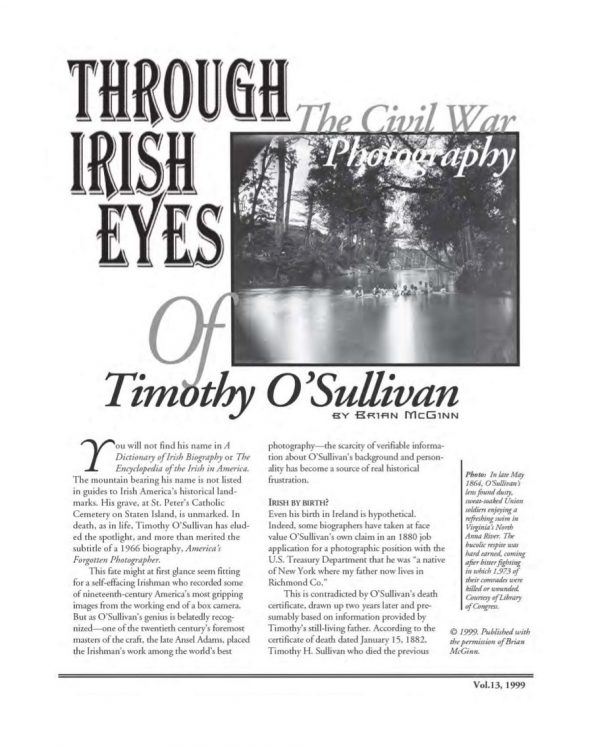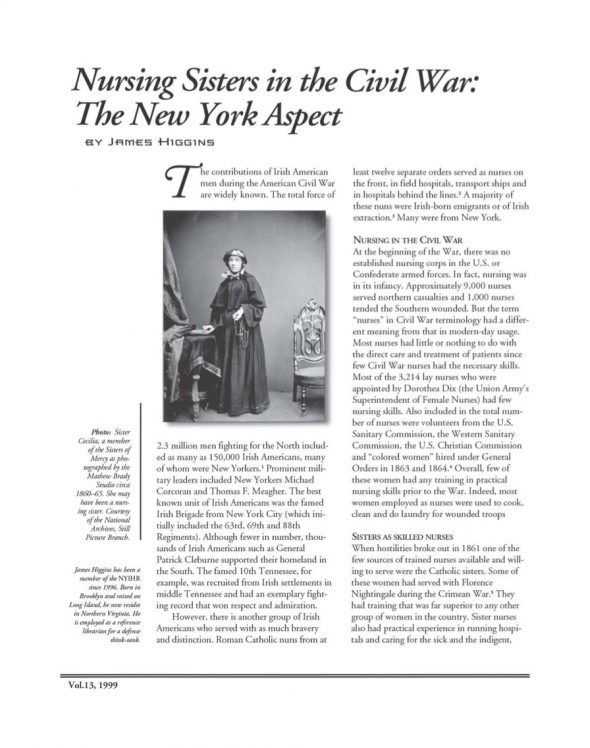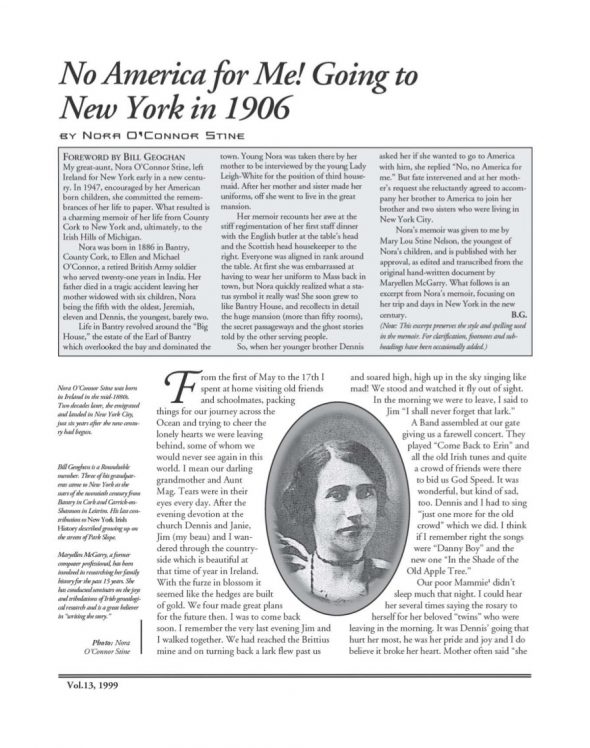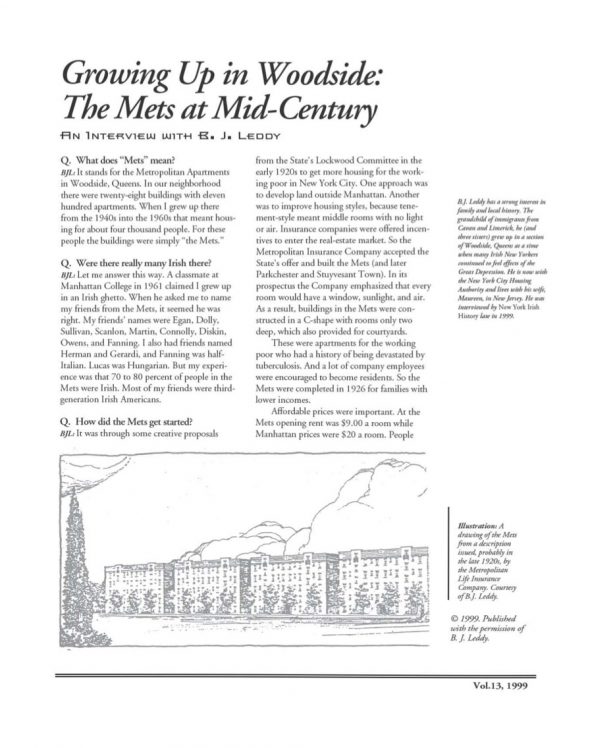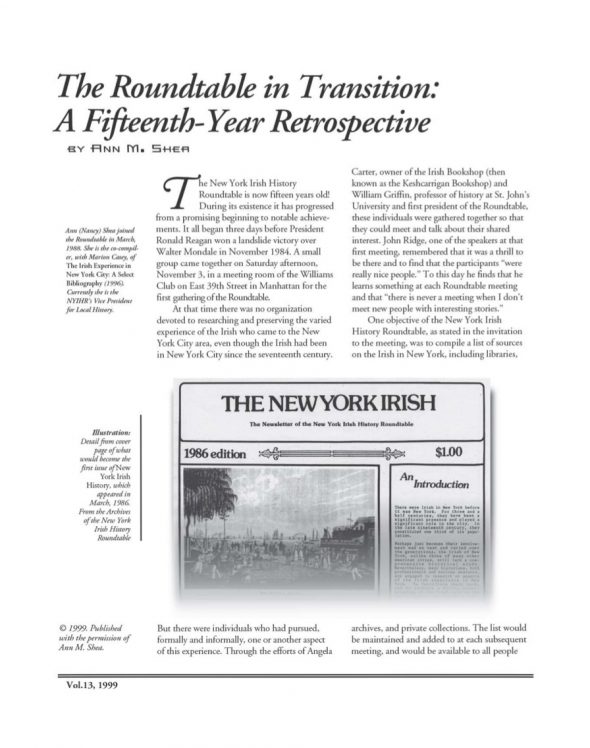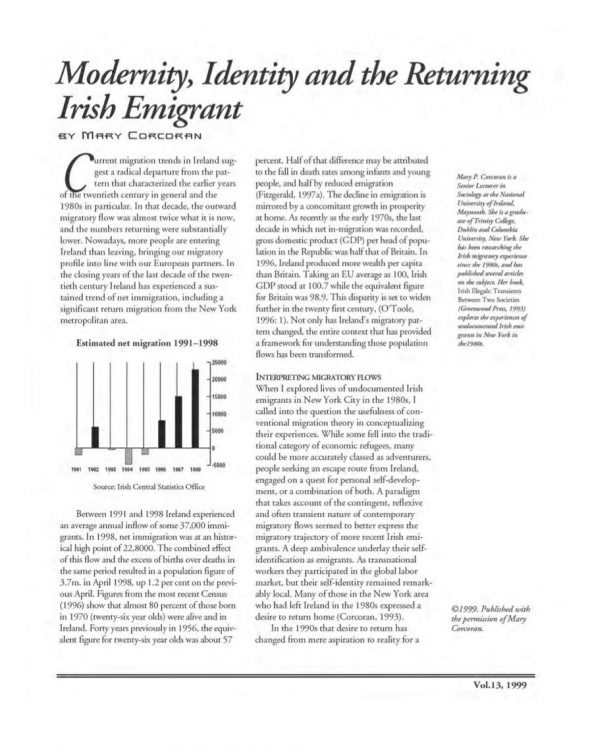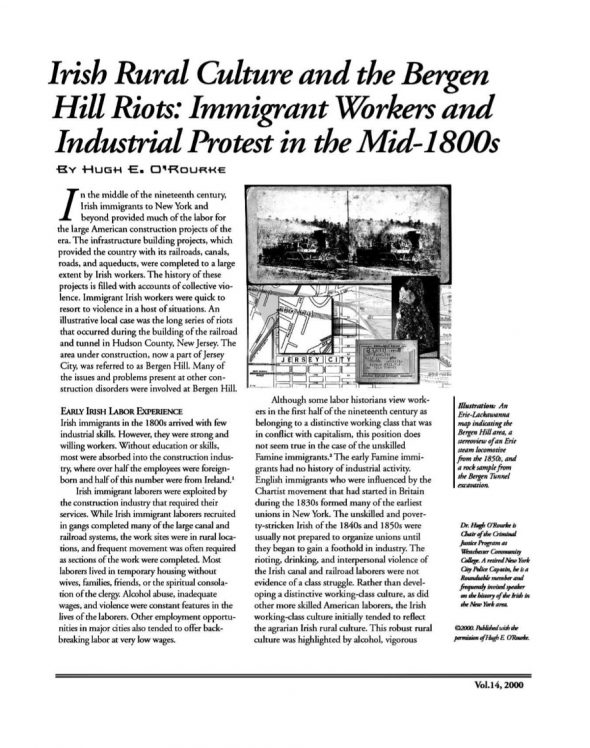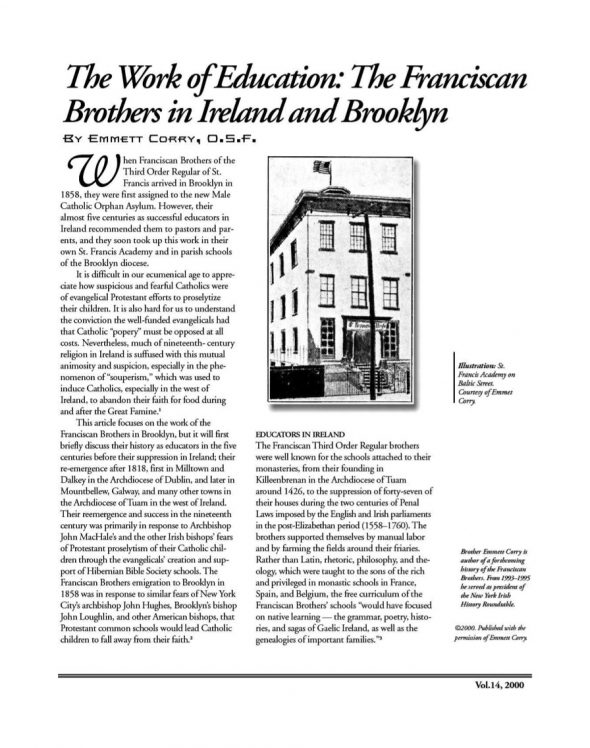New York Irish History Roundtable - Journal Articles
Exiled to New York! A United Irishmans Memories
Author: John Caldwell, Jr.
Publication Year: 1999
Journal Volume: 13
Article Reference: NYIHR-V13-01
The following excerpt is taken from a memoir written by John Caldwell, Jr., in 1849 and tells about his family's exile to America (and New York) because of involvement in the United Irish Rebellion of 1798. The memoir, Particulars of History of a North County Irish Family, also describes John Caldwell's background and his life in Belfast and membership in the United Irishmen prior to 1798. And it describes his father, John Caldwell, Sr., and his family's experiences in the United States from 1799 to 1849. On the eve of the... [Read Full Article]
An Irish or Nativist riot? The Abingdon Square Incident
Author: Hugh E. O'Rourke
Publication Year: 1999
Journal Volume: 13
Article Reference: NYIHR-V13-02
Hugh O'Rourke is a Roundtable member and a Ph.D. candidate in criminal justice at the City University of New York. He is an associate professor and chair of the criminal justice program at Westchester Community College. He is retired New York City Police Captain and a former Lt. Commander, U.S. Naval Reserve.
Illustration: The Abingdon Square riot occurred just south of Fourteenth Street in Greenwich Village, or Manhattan's old Ninth Ward. 0000000 Vol.13, 1999 The riot at Abingdon Square in Greenwich Villageon the Fourth of... [Read Full Article]
Through Irish Eyes - Civil War Photography
Author: Brian McGinn
Publication Year: 1999
Journal Volume: 13
Article Reference: NYIHR-V13-03
You will not find his name in A Dictionary of Irish Biography or The Encyclopedia of the Irish in America.
The mountain bearing his name is not listed in guides to Irish America's historical landmarks. His grave, at St. Peter's Catholic Cemetery on Staten Island, is unmarked. In death, as in life, Timothy O'Sullivan has eluded the spotlight, and more than merited the subtitle of a 1966 biography, America's Forgotten Photographer.
This fate might at first glance seem fitting for a self-effacing Irishman who... [Read Full Article]
Nursing Sisters in the Civil War - The New York Aspect
Author: James Higgins
Publication Year: 1999
Journal Volume: 13
Article Reference: NYIHR-V13-04
James Higgins has been a member of the NYIHR since 1996. Born in Brooklyn and raised on Long Island, he now resides in Northern Virginia. He is employed as a reference librarian for a defense think-tank. 2.3 million men fighting for the North included as many as 150,000 Irish Americans, many of whom were New Yorkers.' Prominent military leaders included New Yorkers Michael Corcoran and Thomas F. Meagher. The best known unit of Irish Americans was the famed Irish Brigade from New York City (which initially included the 63rd, 69th and... [Read Full Article]
No America for Me! Going to New York in 1906
Author: Nora O'Connor Stine
Publication Year: 1999
Journal Volume: 13
Article Reference: NYIHR-V13-05
My great-aunt, Nora O'Connor Stine, left Ireland for New York early in a new century. In 1947, encouraged by her American born children, she committed the rememtown. Young Nora was taken there by her mother to be interviewed by the young Lady Leigh-White for the position of third housemaid. After her mother and sister made her uniforms, off she went to live in the great in asked her if she wanted to go to America with him, she replied "No, no America for me." But fate intervened and at her mother's request she reluctantly... [Read Full Article]
Growing Up in Woodside - The Mets at Mid-Century
Author: B. J. Leddy
Publication Year: 1999
Journal Volume: 13
Article Reference: NYIHR-V13-06
What does "Mets" mean? BJ: It stands for the Metropolitan Apartments in Woodside, Queens. In our neighborhood there were twenty-eight buildings with eleven hundred apartments. When I grew up there from the 1940s into the 1960s that meant housing for about four thousand people. For these people the buildings were simply "the Mets.' Q. Were there really many Irish there? BJL: Let me answer this way. A classmate at Manhattan College in 1961 claimed I grew up in an Irish ghetto. When he asked me to name my friends from the Mets,... [Read Full Article]
The Roundtable in Transition - A Fifteenth-Year Retrospective
Author: Ann M. Shea
Publication Year: 1999
Journal Volume: 13
Article Reference: NYIHR-V13-07
Ann (Nancy) Shea joined the Roundtable in March, 1988. She is the co-compiler, with Marion Casey, of The Irish Experience in New York City: A Select Bibliography (1996). Currently she is the NYIHR's Vice President for Local History.
The New York Irish History Roundtable is now fifteen years old! During its existence it has progressed from a promising beginning to notable achievements. It all began three days before President Ronald Reagan won landslide victory over Walter Mondale in November 1984. A small group came together on... [Read Full Article]
Modernity, Identity and the Returning Irish Emigrant
Author: Mary Corcoran
Publication Year: 1999
Journal Volume: 13
Article Reference: NYIHR-V13-08
Current migration trends in Ireland suggest radical departure from the pattern that characterized the earlier years of the twentieth century in general and the 1980s in particular. In that decade, the outward migratory flow was almost twice what it is now, and the numbers returning were substantially lower. Nowadays, more people are entering Ireland than leaving, bringing our migratory profile into line with our European partners. In the closing years of the last decade of the twentieth century Ireland has experienced a sustained trend of... [Read Full Article]
Irish Rural Culture and the Bergen Hill Riots - Immigrant Workers and Industrial Protest in the Mid-1800s
Author: Hugh E. O'Rourke
Publication Year: 2000
Journal Volume: 14
Article Reference: NYIHR-V14-01
In the middle of the nineteenth century, Irish immigrants to New York and beyond provided much of the labor for the large American construction projects of the era. The infrastructure building projects, which provided the country with its railroads, canals, roads, and aqueducts, were completed to a large extent by Irish workers. The history of these projects is filled with accounts of collective violence. Immigrant Irish workers were quick to resort to violence in a host of situations. An illustrative local case was the long series of riots... [Read Full Article]
The Work of Education - The Franciscan Brothers in Ireland and Brooklyn
Author: Emmett Corry, 0.S.F.
Publication Year: 2000
Journal Volume: 14
Article Reference: NYIHR-V14-02
When Franciscan Brothers of the Third Order Regular of St.Francis arrived in Brooklyn in W 1858, they were first assigned to the new Male Catholic Orphan Asylum. However, their almost five centuries as successful educators in Ireland recommended them to pastors and parents, and they soon took up this work in their own St. Francis Academy and in parish schools of the Brooklyn diocese.
It is difficult in our ecumenical age to appreciate how suspicious and fearful Catholics were of evangelical Protestant efforts to proselytize their... [Read Full Article]

